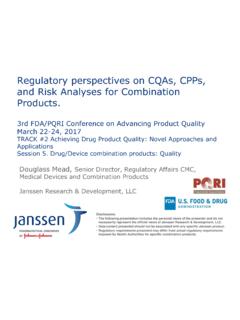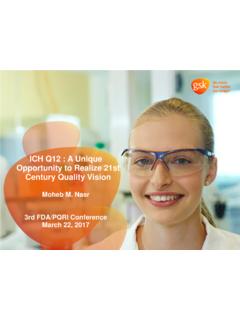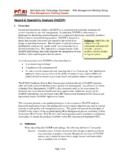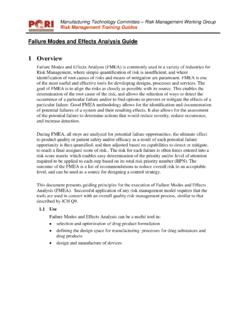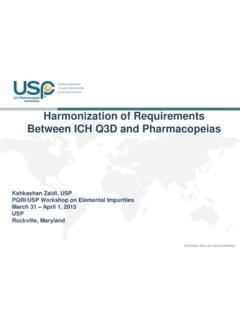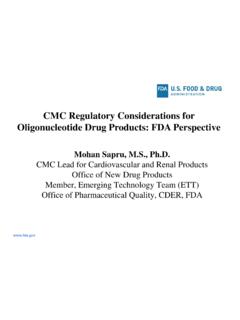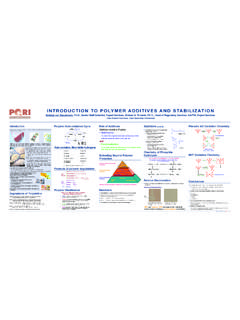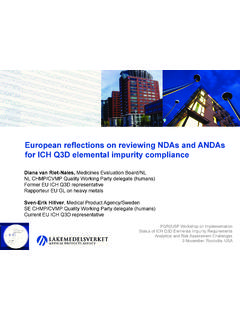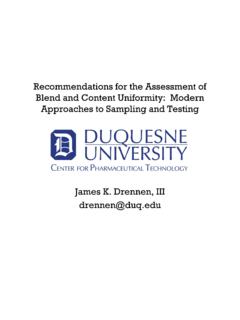Transcription of Process Robustness – A PQRI White Paper
1 A pqri White PaperNOVEMBER/DECEMBER 2006 PHARMACEUTICAL ENGINEERING On-Line Copyright ispe 2006 The ProductQuality ResearchInstitute ( pqri )is collaborativeeffort betweenthepharmaceuticalindustry,regulat oryagencies, andacademia. Oneof the purposesof pqri is topromotediscussion oncurrent topics ofinterest in thepharmaceuticalfield. To thatend, pqri commissioned aworking group todevelop a WhitePaper thatdiscusses theconcept ofprocessrobustness andhow it applies todevelopment,scale up, andmanufacture Robustness A pqri WhitePaperby pqri Workgroup MembersMichael Glodek, Merck Stephen Liebowitz, Bristol-Myers Squibb; Randal McCarthy,Schering Plough; Grace McNally, FDA; Cynthia Oksanen, Pfizer; Thomas Schultz, Johnson Mani Sundararajan, AstraZeneca; Rod Vorkapich, Bayer Healthcare; KimberlyVukovinsky; Pfizer, Chris Watts, FDA.
2 And George Millili, Johnson & Johnson - MentorIntroductionObjectiveThe ability of a manufacturing Process totolerate the expected variability of rawmaterials, operating conditions, pro-cess equipment, environmental condi-tions, and human factors is referred to as objective of this Paper is to unify under-standing of the current concepts of processrobustness and how they apply to pharmaceu-tical manufacturing. The Paper also providesrecommendations on development and main-tenance of a robust Process . The concepts pre-sented here are general in nature and canapply to many manufacturing situations; how-ever, the focus of the discussion is applicationof Robustness principles to non-sterile soliddosage form manufacturing.
3 The tools, casestudies, and discussion presented in this papercenter around new product development andcommercialization as, ideally, Process robust-ness activities start at the earliest stages ofprocess design and continue throughout thelife of the product. It is also recognized thatconcepts of Robustness can be applied retro-spectively to established products in order toenhance Process is a heightened emphasis on greaterprocess understanding in the pharmaceuticalindustry. There is great incentive from amanufacturer s point of view to develop robustprocesses. Well understood, robust processessuggest greater Process certainty in terms ofyields, cycle times, and level of discards.
4 Lowerfinal product inventories may be carried if themanufacturing Process is is a growing expectation from globalregulatory agencies that firms demonstrate acomprehensive understanding of their processesand controls. The finalized FDA report entitled Pharmaceutical cGMPs for the 21st Century -A Risk-Based Approach clearly expresses theexpectation that firms strive for the imple-mentation of robust manufacturing processesthat reliably produce pharmaceuticals of highquality and that accommodate Process changeto support continuous Process improvement. As evidenced by recent draft guidelines, theother members of the ICH tripartite have alsoadopted the philosophy embraced by this Risk-Based Approach.
5 The eventual implementa-tion of recommendations contained in ICH Q8and Q9 should establish the linkage between knowledge and associated risk. An underly-ing principle of ICH Q8 is thatan assessment of Process ro-bustness can be useful in riskassessment and risk reduc-tion. Furthermore, such an as-sessment of Process robustnesscan potentially be used to sup-port future manufacturing andprocess optimization, espe-cially in conjunction with theuse of structured risk man-agement tools outlined in thedraft ICH Q9 guidance. TheFigure1. ProvenAcceptable Range (PAR).Exclusive On-Line ArticlePHARMACEUTICAL ENGINEERING The Official Magazine of ISPEN ovember/December 2006, Vol. 26 No. 6 Process Robustness2 PHARMACEUTICAL ENGINEERING On-Line Exclusive NOVEMBER/DECEMBER Copyright ispe 2006establishment of robust processes serves the best interests ofthe patients, global regulatory agencies, and firms.
6 It isanticipated that such processes will consistently produce safeand efficacious products in a cost effective manner. While notin the scope of this document, it is also anticipated thatregulatory agencies will adjust their oversight requirementsfor processes that are demonstrated to be robust, as suchprocesses are anticipated to present low risk for productquality and is more to a robust Process than having a dosageform pass final specifications. Robustness cannot be testedinto a product; rather, it must be incorporated into the designand development of the product. Performance of the productand Process must be monitored throughout scale up, intro-duction, and routine manufacturing to ensure Robustness ismaintained and to make adjustments to the Process andassociated controls if necessary.
7 Process understanding - howprocess inputs affect key product attributes - is the key todeveloping and operating a robust Paper presents key concepts associated with processrobustness, defines common terms, details a methodicalapproach to robust Process development, and discusses toolsand metrics that can be used during development or forongoing Process monitoring. Where appropriate, case studiesare used to demonstrate concepts. The tools, approaches, andtechniques discussed are commonly understood concepts andare routinely used in other industries. Many pharmaceuticaldevelopment and manufacturing programs are employingsome or all of the techniques. The intent is to organize theapproaches and show how, when used together, they can leadto greater Process understanding and of Process RobustnessDefining RobustnessThe ability of a Process to demonstrate acceptable quality andperformance while tolerating variability in inputs is referredto as Robustness .
8 Robustness is a function of both formulationand Process design. Formulation design variables include thequalitative and quantitative composition of raw materials,both API and excipients. Process design variables include theprocess selected, the manufacturing sequence or steps, theequipment settings, such as speeds and feed rates, andenvironmental conditions. In this discussion, all processinputs will be referred to as and variability are factors impacting robust-ness and may be managed through Process design and prod-uct composition. Elements of product composition for consid-eration include the choice of API form, since some API formsare more robust than others, and the choice of the excipients, , the grades and performance and variability may be managedthrough the choice of manufacturing technology.
9 Settingappropriate parameter ranges for a robust Process requiresconsideration of the manufacturing technology selected. Spe-cial considerations are needed for situations/processes wherethe appropriate setting of one parameter depends on thesetting of another. Well designed processes reduce the poten-tial for human mistakes, thereby contributing to typical pharmaceutical manufacturing Process is com-prised of a series of unit operations. A unit operation is adiscrete activity , blending, granulation, milling, or com-pression. Parameters for a unit operation include: machin-ery, methods, people, material (API, excipients, materialused for processing), measurement systems, and environ-mental conditions.
10 The outputs of a unit operation are de-fined as attributes, , particle size distribution or product and Process development both the inputsand outputs of the Process are studied. The purpose of thesestudies is to determine the critical parameters and attributesfor the Process , the tolerances for those parameters, and howbest to control them. Various experimental and analyticaltechniques may be used for Process characterization. Thegoal of this development phase is to have a good understand-ing of the Process and the relationships of the parameters tothe attributes. The body of knowledge available for a specificproduct and Process , including critical quality attributes andprocess parameters, Process capability, manufacturing andprocess control technologies and the quality systems infra-structure is referred to as the Manufacturing Science under-lying a product and Process .
